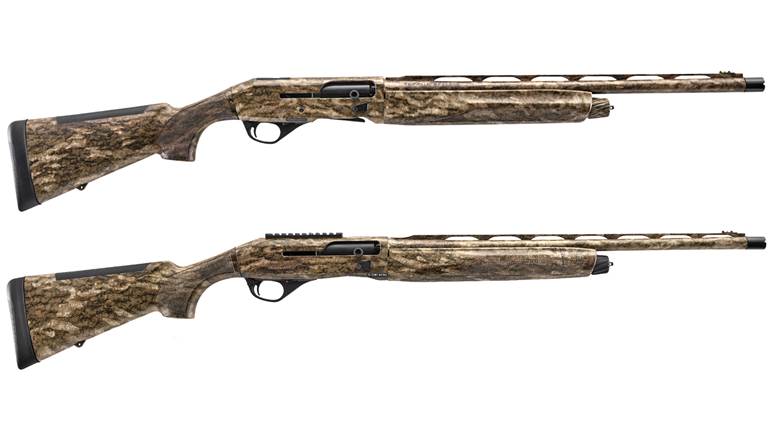
If you compare the numbers and the ballistics of various shotshell gauges, the 28-gauge shotshell is relatively uninspiring. So why then is its admittedly small following so loyal? I could tell you that it’s one of those cartridges that seems to perform better than it should. But, physics is physics, and it’s difficult to justify such a claim with science, even if I believe it to be true.
With a bore diameter of 0.550 inches it does not quite split the difference between the 20 gauge (0.615 inches) and the runt in the family, the .410-bore, as is often assumed, rather it favors the larger. The 2¾-inch, 28 gauge’s most popular game load is 3/4-ounces of shot at 1,300 fps. The 2¾-inch, 20-gauge “High Brass” load uses a full ounce of shot at 1,220 fps, and the 2½-inch .410 load shoots a half-ounce payload at 1,200 fps. The performance of the 28 is closer to the 20 than the .410, a fact to which anybody who has used all three in the field will vigorously attest.
For many years I believed that the only shotgun worth using was a 12 gauge, and even then only because the 10-gauge guns were too clubby. I thought bigger was better, because I figured the more shot in the air, the better my chances of hitting something. Then I discovered smaller shotguns when I bought an AL48 28-gauge semi-automatic from Benelli’s sister company Franchi. That led to several more 28-gauge shotguns. I was shocked at how well I could shoot a 28 gauge and how well it performed on game—and not on just quail or doves, but ruffed grouse, woodcock and even snowshoe hares.
In fact, one hunting buddy, Dave Kinsman, uses a 28 gauge exclusively during our winter snowshoe hare hunts, and at the end of the day he always seems to have more in his game-bag than the rest of us. These “white rabbits” are big and tough targets compared to quail, but the 28 gauge does a fine job of putting them in the crock pot. But to claim it performs at the same level as the larger-bore shotguns is to risk ridicule.
No, the reason for the continuing popularity of the 28 gauge with hard-core shotgun shooters is quite simply the guns. Some gun companies will tell you the 28 gauge is dead and “it ain’t ever comin’ back.” I can guarantee those companies slapped 28-gauge barrels on their 20-gauge shotgun frames and then wondered why nobody bought them. The glory of the 28 gauge is found best when the gun is built on a frame that is scaled to the shell size. The 28-gauge shotgun, correctly proportioned, is a delightful, lively, light and spirited shotgun that is a pleasure to carry and shoot.
The new kid on the block in 28-gauge shotguns is a semi-automatic from a company that understands what it takes to make a 28-gauge shotgun correctly. I am not ashamed to say that when I had the good fortune to shoot the new Benelli Legacy 28 shotgun, it was love at first sight.
I was hunting and filming with the “Benelli On Assignment” television crew at Greystone Castle in Mingus, Texas, when Vice President of Marketing Steve McKelvain handed me the new shotgun. I broke a clay target as it flew from the trap house. But that paled in comparison to later in the trip, when I was able to use the gun while quail hunting. By the end of the day I was ready to fight anybody who might have tried to take the gun away from me. The Legacy 28 was that good.
Quail hunting usually requires a lot of walking to follow the dogs. Often by dusk even my bootlaces are too heavy. So my thinking is that the less the shotgun weighs, the more I’ll like it as the miles add up. The Legacy 28 felt very good in my hand as I was carrying it, and when it came time to shoot, it was light and lively and fast at the flush. The balance point on the 26-inch-barreled model is 5 inches ahead of the trigger. This weight-forward balance helps to point the gun instinctively and to track moving birds smoothly. I shot it better than I deserved, and few quail escaped.
At 4 pounds, 14 ounces, the Legacy 28 is the lightest semi-automatic on the market, according to Benelli. This is partly because the frame and action are scaled to the 28-gauge shotshell. It’s a smaller, more petite shotgun than even the 20-gauge Legacy. Also, it operates with Benelli’s relatively simple inertia system, which helps to minimize its overall weight.
The Benelli is one of the fastest operating shotgun systems on the planet. Tests done by my friend Pat Kelley, who is one of the top 3-gun shooters in the world, show that the 12-gauge “Inertia Driven” Benelli can cycle fast enough to allow the next shot in 0.13 second. That’s faster than most of the shooters in the world can work the trigger. Also, the inertia system expels most of the gas, carbon, dirt and debris out the muzzle of the shotgun. A gas-operated semi-automatic will divert more gas—and inadvertently, other gunk—back into the gun to provide the energy to cycle the shotgun. This works well until the gunk builds up from repeated firing, and then the guns start to misbehave. The Benelli system stays cleaner, so it keeps working through hundreds of shots. That’s likely not a big deal for a grouse or quail hunter who may shoot only a couple of dozen times in a day, but to somebody having a great day in a dove field, where ammunition is lugged in by the case, it can be critical to keeping the gun working.
The Legacy 28 gauge I had for testing was the 26-inch-barreled version. The cryo-treated barrel is finished in a deep luster blue and is fitted with a carbon-fiber ventilated rib. The rib is not tight on the gun, but “floats.” This is so the metal in the barrel can expand as it heats up without interference from the rib, as carbon fiber expands at a different rate. This keeps the shotgun honest and shooting to the correct point of aim, even when it’s sizzling hot. There is a large fiber-optic front sight and a small, round, metal mid-bead. The gun uses screw-in chokes and ships with a cylinder and a modified. I would like to see improved-cylinder and improved-modified or full chokes added to handle the variations found in the bird hunting fields.
The upper receiver is high-polish blue, which contrasts well with the matte-silver lower receiver. This lower receiver is engraved, or as Benelli calls it, “sculptured,” with classic game-scene acid etchings. Both sides have an oval gold inlay with the number “28” engraved. The trigger guard is matte-black, and the trigger is gold. The bolt and bolt handle are high-polish chrome. The stock is AA-grade walnut with enough figure in it to keep the gun interesting. The machine-cut checkering is even, perfect and bland. It’s the one flaw on this otherwise striking shotgun. The diamond’s peaks are rounded where they should be pointed. The stock has a satin finish with Benelli’s “WeatherCoat” protection. The butt pad is ½-inch-thick black rubber. The grip cap is inlaid clear plastic with a black background and a silver “28.” The slender fore-end is checkered, with “Benelli” laser engraved above the checkering. The magazine cap is black-finished, sculptured in an hourglass shape and with a pattern of elliptical cutouts that seem to work in harmony with the “modern elegance” theme of the shotgun.
The gun ran flawlessly. I tried a variety of target and hunting loads and never experienced a single hiccup. It points well for me, but had it not, the gun comes with a shim kit to customize the stock fit to the shooter.
I can’t imagine that the 28 gauge will ever rise to the popularity of the 12 gauge with the American shooting public, or even the 20 gauge for that matter. But, with the new Benelli Legacy on the market, the future for this wonderful little shotshell is a lot more secure.
Manufacturer: Benelli Armi SpA, Urbino PU, Italy
Importer: Benelli USA; (800) 264-4962; www.benelliusa.com
Action Type: semi-automatic, recoil-operated shotgun
Gauge: 28, 2¾"
Receiver: steel upper; engraved aluminum alloy lower
Barrel: blue, 26" (tested), 24"; carbon-fiber, full-length vented rib
Chokes: interchangeable, screw-in chokes; cylinder and modified supplied.
Magazine: tubular, two-round capacity
Overall length: 45½" (24" barrel)
Weight: 4 lbs., 14 ozs.
Trigger Pull: single-stage; 5 lbs., 1 oz.
Stock: AA Grade walnut with satin finish and WeatherCoat: length of pull, 143⁄8"; drop at comb, 1½"; drop at heel, 2¼"
Accessories: improved cylinder and cylinder chokes; choke tube wrench; owner’s manual
Suggested Retail Price: $1,989






































